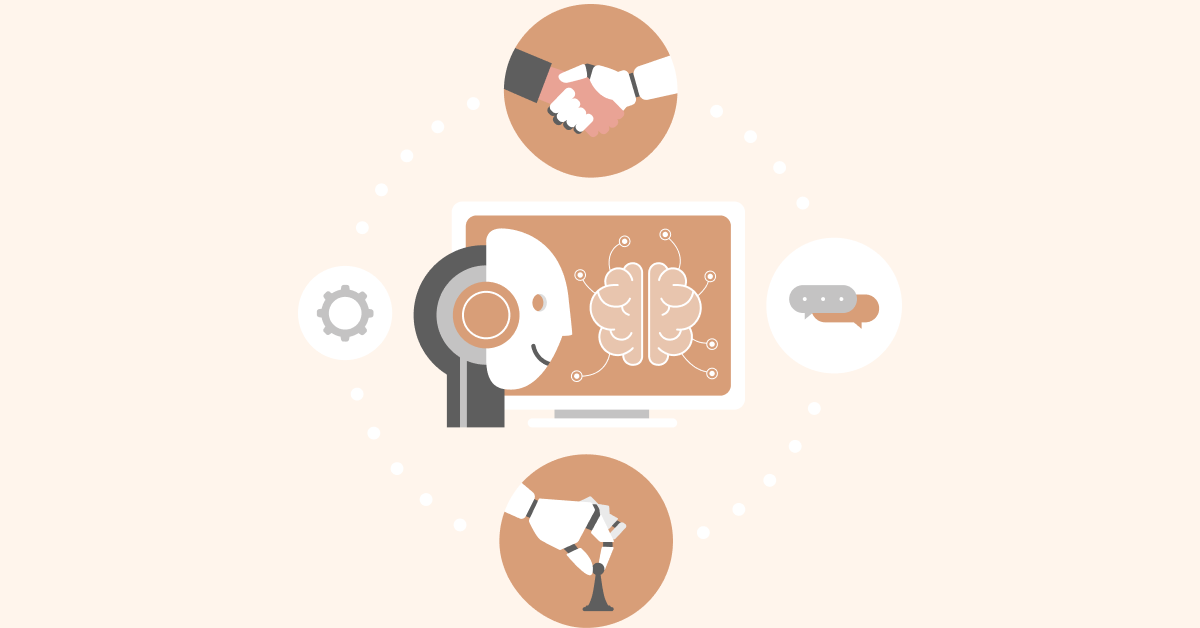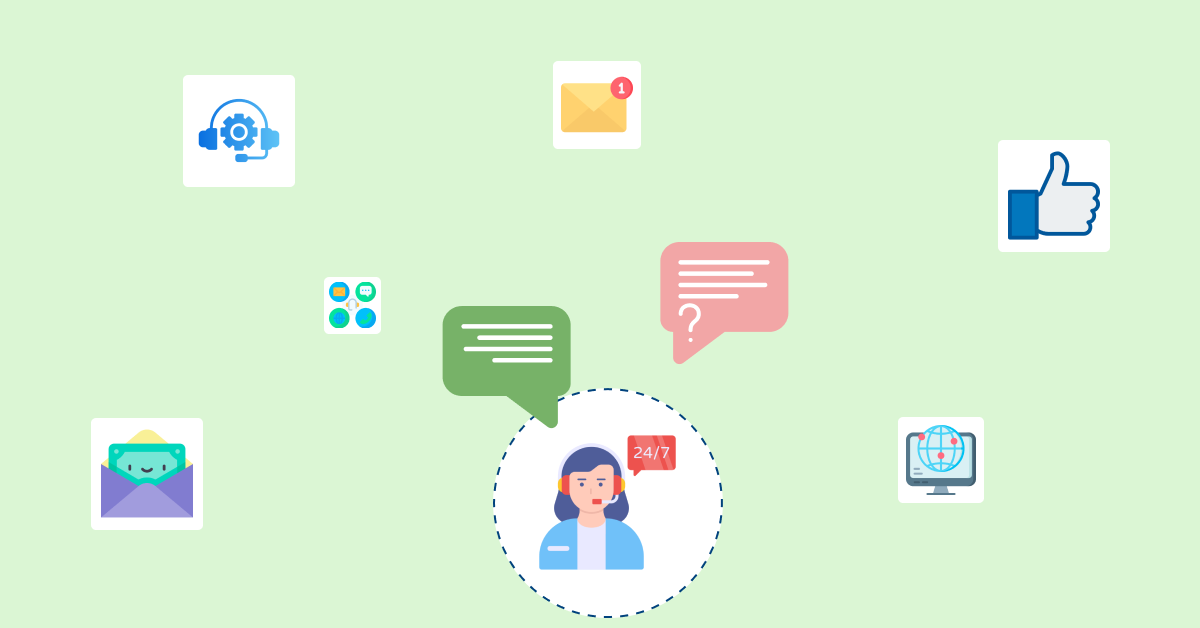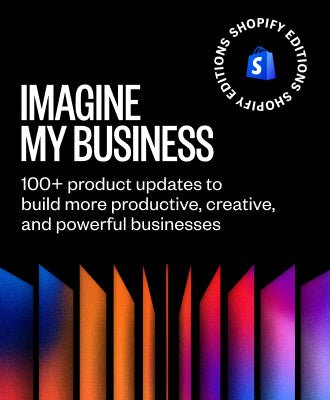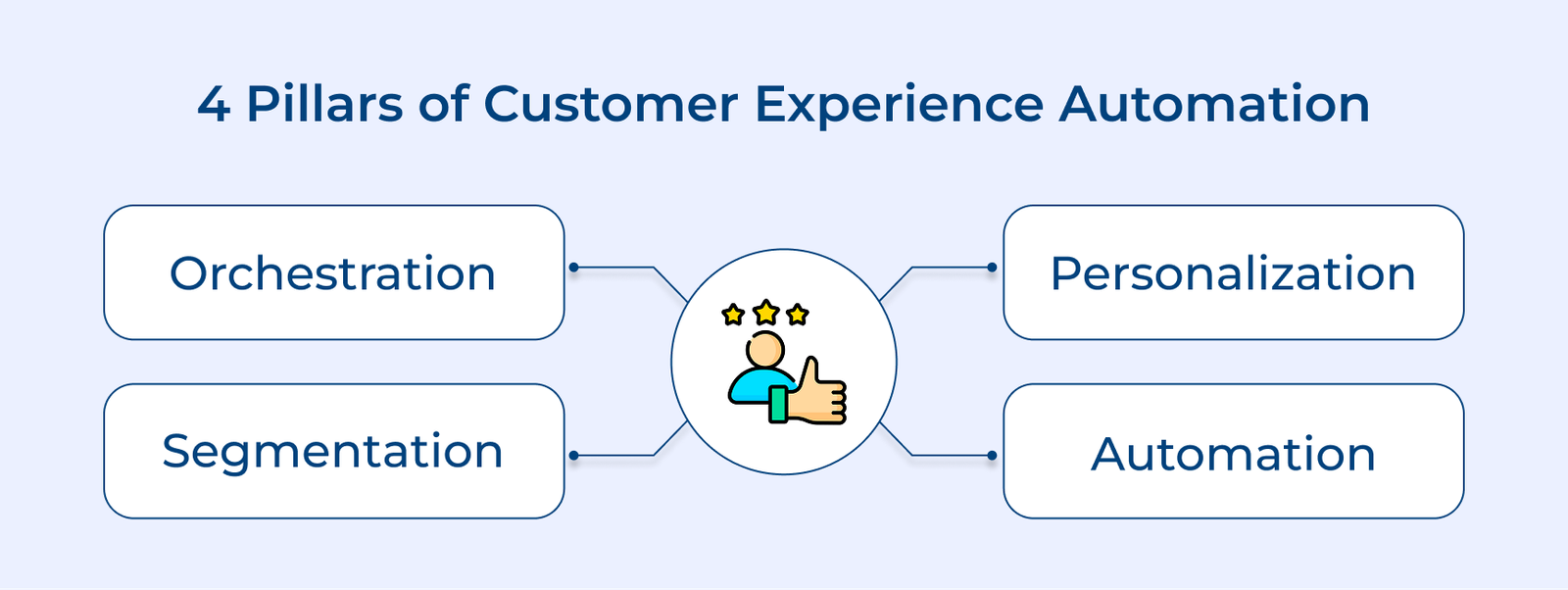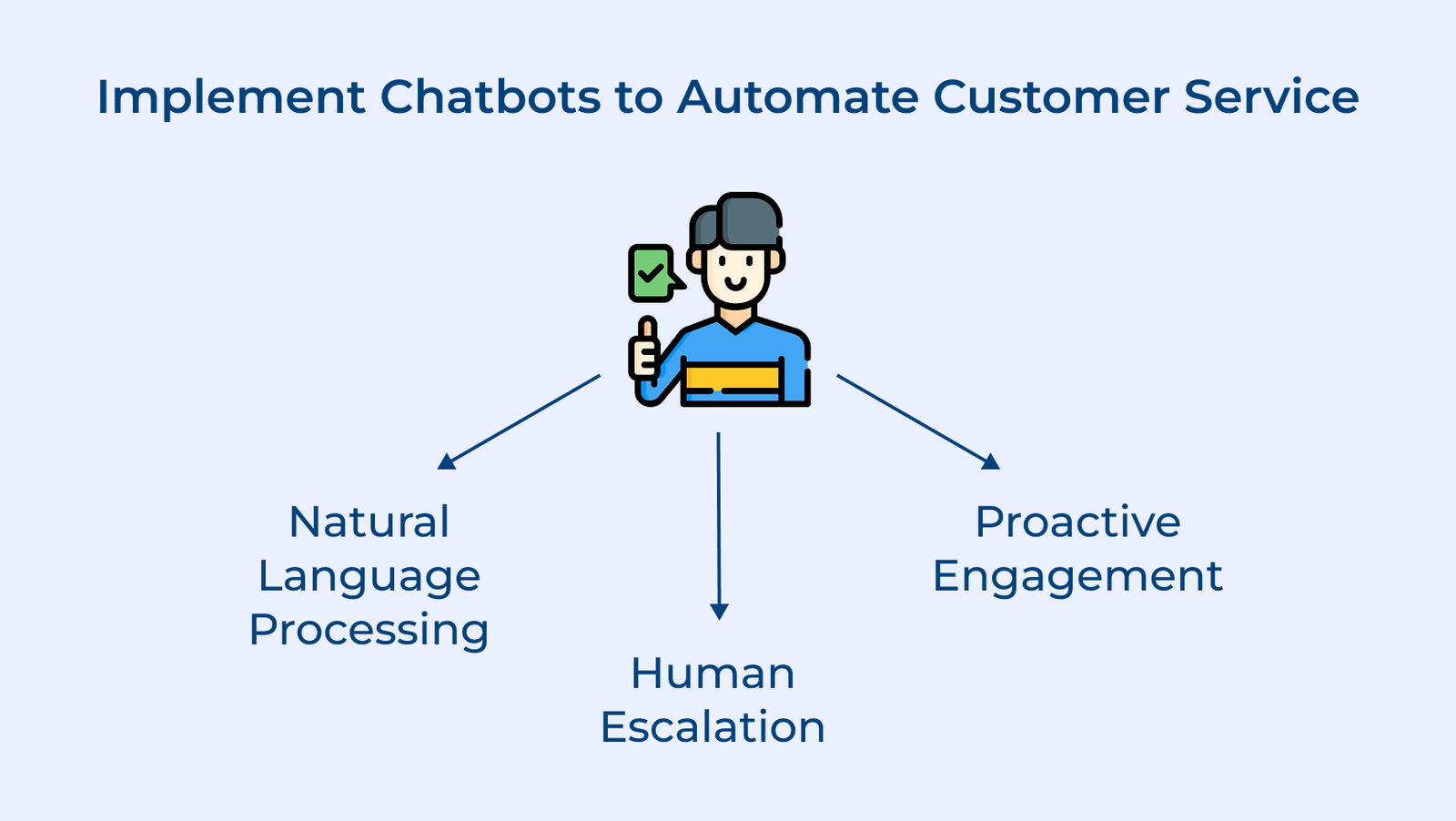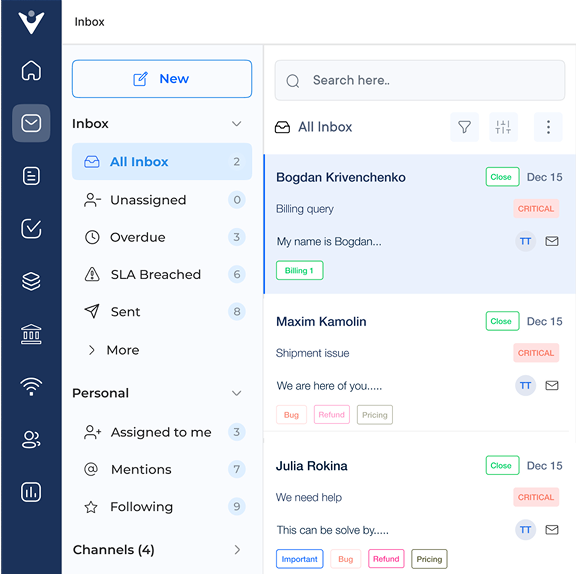Chatbots can serve hundreds of customers simultaneously round-the-clock making it easy for customers to connect with businesses without delay. Quick resolutions using automated self-help options not only save time but also lead to happier experiences for customers. They don’t have to keep waiting for responses such as on calls or emails.
Best Practices:
- Natural language processing: Equip chatbots with advanced natural language processing to understand and respond to customer queries conversationally.
- Human escalation: Integrate chatbots with the ability to seamlessly transfer customers to human agents when complex issues arise, ensuring a smooth transition for a better CX.
- Proactive engagement: Use chatbots to initiate conversations, offer assistance and provide relevant information, enhancing engagement.
3. Set up Automated Help Desk Workflows
Customer experience (CX) automation improves the process by setting up automated help desk workflows. It ensures that customers’ inquiries are addressed in a timely and efficient manner, leading to greater satisfaction. 50% of business leaders plan to automate more repetitive tasks within their organizations.
Companies must consider investing in platforms specifically designed for automating workflows. Many options are available that integrate with other software systems you may already be using – such as email or chatbots – making it easy for your team to manage all customer inquiries. You can configure these tools by creating customized templates that allow you to easily route incoming inquiries.
Best Practices:
- Categorization and prioritization: Design automated workflows that classify and prioritize incoming inquiries based on urgency, ensuring critical issues receive immediate attention.
- Escalation paths: Implement automated systems that route inquiries to specialized teams or higher-level support when required, improving efficiency and resolution times.
- Follow-up and feedback: Set up automated follow-up emails after resolving inquiries, asking for feedback to gauge customer satisfaction and gather insights for continuous improvement.
4. Trigger Automated Surveys for Instant Feedback
Another way automation enhances CX is by using surveys to collect instant feedback from customers. They share their experience of interacting with your company’s products or services. The insights gained from the feedback allow businesses to make changes that better meet the needs of their customers.
Set up automatic surveys sent via email or SMS text after a customer interacts with your company’s offerings such as customer support, delivery, or purchase experiences. Automating these surveys directly after interactions allows companies to get immediate feedback about what worked well and what didn’t work at any given touchpoint.
Best Practices:
- Timely feedback requests: Automatically send surveys immediately after customer interactions to capture their experience while it’s fresh in their minds.
- Short and focused surveys: Design succinct surveys with targeted questions that provide valuable insights without overwhelming customers.
- Closed-loop feedback: Automate responses to survey submissions, acknowledging customer feedback and communicating how their input will be used to enhance their experience.
5. Offer Self-Service Options for 24×7 Support
Modern consumers demand instant gratification and that includes support whenever they need it. Providing round-the-clock human assistance can be resource-intensive for small and medium-sized enterprises (SMEs). 91% say they would use a knowledge base if it met their needs.
Start by deploying chatbots or virtual assistants that can handle frequently asked questions (FAQs), like product inquiries, order updates, or cancellation requests. When these solutions are integrated with automation software powered by artificial intelligence (AI), customers can receive accurate and valuable instant responses.
Best Practices:
- Comprehensive knowledge base: Build a robust self-service knowledge base with FAQs, tutorials and troubleshooting guides.
- Automated content delivery: Implement chatbots that can deliver relevant articles or resources from the knowledge base based on customer queries, aiding self-service.
- Self-service escalation: Provide a pathway for customers to seamlessly transition from self-service to human assistance if their queries cannot be resolved through automated options.
6. Streamline Operations with Automated Workflows
One of the most significant benefits of customer experience (CX) automation is its ability to streamline workflows and simplify processes across departments. Reducing manual tasks such as data entry or information retrieval gives the employees more time to focus on high-priority tasks like quality assurance or problem-solving.
For instance: In customer service teams – automated workflows that create tickets from incoming emails will help in acknowledging customers’ queries faster than before since the first response is sent immediately.
Best Practices:
- Task automation: Automate routine tasks such as data entry, document creation, and appointment scheduling, allowing employees to focus on higher-value activities.
- Cross-functional integration: Use automation to integrate different software systems used across departments, enabling smoother collaboration and more holistic customer insights.
- Automated alerts: Set up alerts for critical events or customer actions, ensuring timely responses and proactive engagement by your team.
7. Leverage CRM Systems with Automation Features for Lead Scoring and Sorting
One area where automation can significantly improve CX is through the use of Customer Relationship Management (CRM) systems. A CRM system that leverages automation features for lead scoring and sorting, ensures that potential leads are handled systematically.
Lead scoring allows businesses to determine which leads are most valuable based on certain criteria such as level of engagement or interest in a particular product or service. An automated lead scoring system ensures that businesses no longer have to spend hours manually sifting through leads themselves. The system does it automatically so that sales reps can prioritize their efforts accordingly.
Best Practices:
Lead qualification: Implement automated lead scoring to prioritize leads based on their engagement level, ensuring your sales team focuses on the most promising prospects.
Automated follow-ups: Use CRM automation to schedule and send follow-up emails or messages to leads, nurturing relationships.
Personalized outreach: Leverage CRM automation to send tailored content or offers to leads based on their interactions, enhancing the relevance of your communication.
8. Automate Appointment Booking Processes
Another way customer experience (CX) automation enhances the approach is through automating appointment booking processes. When customers want to meet with your business’ sales staff, they usually need to schedule an appointment first – a process that often involves back-and-forth communication until both sides agree on a time that works for everyone involved.
Automating the entire process reduces friction points by allowing customers to book appointments without having to engage in lengthy correspondence back-and-forth exchanges. It not only frees up sales teams’ time but also simplifies scheduling by making it possible for people worldwide to just click on their desired meeting slot available.
Best Practices:
- Real-time availability: Implement an automated booking system that displays real-time availability and allows customers to select convenient appointment slots.
- Automated reminders: Set up automated reminders via email or SMS to reduce no-shows and enhance customer satisfaction.
- Easy rescheduling: Provide customers with the ability to reschedule appointments through the automated system, offering flexibility and convenience.
9. Build Your Online Reputation with Automated Reviews
Positive online reviews are crucial for any business operating now. 95% of consumers read online reviews before making a purchasing decision, and they trust these reviews just as much as personal recommendations. Building a strong online reputation requires a proactive approach to managing and responding to customer feedback.
An automated review management system allows businesses to streamline the process of gathering customer feedback and responding promptly. The tools empower businesses to solicit reviews from customers via email or SMS and integrate with popular review sites like Google My Business or Yelp.
Best Practices:
- Timely review requests: Automate the process of requesting reviews from customers shortly after a purchase or interaction, when their experience is fresh.
- Monitor and respond: Use automation tools to monitor online reviews and automatically respond to positive as well as negative feedback, showcasing your commitment to customer satisfaction.
- Feedback integration: Integrate review feedback into your improvement processes, using insights gained to refine your offerings and enhance CX.
10. Streamline the Checkout Process through Automation Tools
Cart abandonment is one of the most significant challenges facing e-commerce retailers today. Majority of the online shopping carts are abandoned before checkout is complete due to reasons like high shipping costs, complicated checkout processes, or lack of payment options.
Automation can help simplify the checkout process for buyers by providing quick access to relevant product information (such as shipping fees) before they reach the payment page. Retailers may also use automation tools such as chatbots or virtual assistants that can help guide shoppers through the purchase process.
Best Practices:
- Transparent pricing: Employ automation to display accurate pricing, including shipping costs and any applicable taxes, upfront during the checkout process.
- Autofill and guest checkout: Enable autofill for returning customers and offer guest checkout options to streamline the process. It results in reducing friction and increasing conversion rates.
- Real-time support: Implement automation tools that offer instant customer support during the checkout process, helping customers with any inquiries that might arise.
Start Automating Your Customer Experience (CX)
The importance of providing a seamless end-to-end customer experience cannot be ignored in the highly competitive marketplace. With automation becoming increasingly accessible, there is no reason not to start exploring how it can benefit your business.
Start by assessing your existing processes and identifying areas where automation could have the most impact. Then gradually integrate relevant technology into your operations while keeping an eye on performance metrics. Following this approach will allow you to take advantage of evolving technology trends while delivering an exceptional CX that sets you apart from the competition.



